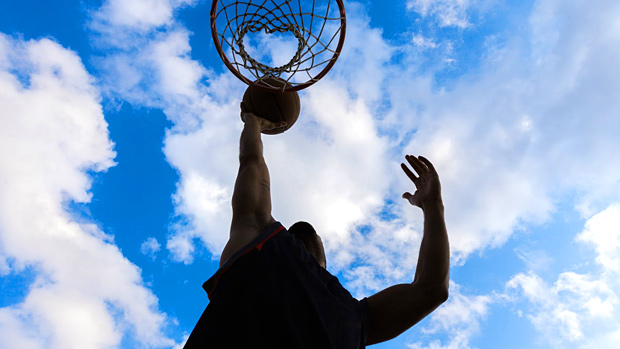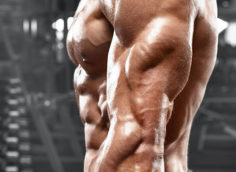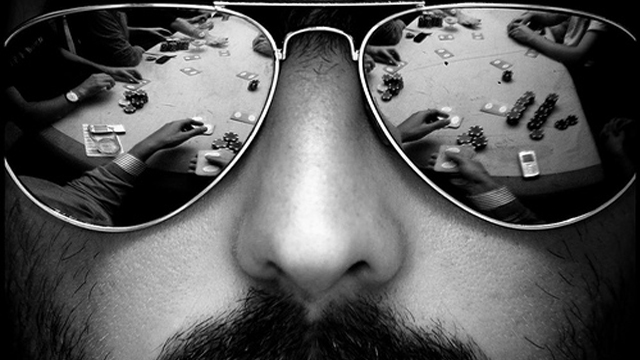In Mythbusters Volume 4, our panel of experts put the kibosh on dangerous, demented, or just plain dumb myths that keep us from building lean, muscular bodies.
In Volume 5, Clay Hyght, Craig Weller, Nick Tumminello, and Matt McGorry get medieval with a new list of suspect beliefs that are commonly held by modern muscleheads.
Myth: Steroids make all the difference.
Mythbuster: Clay Hyght

As a T Nation reader, you're savvy enough to know that many elite athletes in a variety of sports use ergogenic aids like steroids and growth hormones. However, I'm willing to bet you don't know how big of a role these aids really play. It's far less than you may expect.
Remember the first time you took creatine, and your weight and strength went up quicker than ever? Multiply that by two or three, and you get a rough idea of what you could expect by taking steroids. It's an advantage, sure, but it's not the kind of boost you hear about in locker rooms and Internet forums worldwide.
First, an analogy.
Let's say you and I go to the dog track and we decide to play a friendly game where we bet on a dog without seeing him first. All we know is that Dog One has been taking stanozolol (Winstrol) for two years and clenbuterol for a few months, all while training and eating perfectly. Dog Two has also been training and eating perfectly, but hasn't taken any ergogenic aids at all.
Which dog would you put your money on? Dog One, right? It's a no-brainer.
But what if Dog One is a Chihuahua, while Dog Two is a greyhound? Knowing this, would you still bet on the first dog? Not unless you're a fool eager to be parted from his money.
You can extend that analogy in any direction. Just as no amount of drugs would give that Chihuahua a chance in hell against a dog bred specifically for speed, he'd get his ass handed to him in a fight against a drug-free pit bull, or in a sled-pulling contest against a husky with clean urine samples. Genetic advantages rule.
The point I'm trying to make is that those who are at the upper echelons in any sport are the greyhounds, pit bulls, and huskies of the human species. It doesn't matter if we're talking about bodybuilding, track and field, football, or any other sport in which size, strength, and power are the primary tools required. The top athletes in those sports have that big-dog potential with or without steroids.
You think Ronnie Coleman won eight Mr. Olympias because he took more drugs, or better drugs, than everyone else? Hell no! In fact, he won his first bodybuilding titles when he was still drug-free.
He never misses a workout, trains as if his life depends on it, and eats every scheduled meal every single day. It was his hard work and dedication that allowed him to capture eight Olympia trophies. Sure, steroids played a role, but if it hadn't been for his freaky genetics, hard work, and consistent focus, the pharmacology wouldn't have mattered.
A guy with average genetics and a mediocre work ethic could take all the steroids in Bulgaria and still not win the novice division at a local bodybuilding show. But give me a drug-free guy with good genetics who's willing to work hard and eat right, let me put him up against a lazy juicer, and I guarantee my guy will win.
If I told you the steroid protocol of some of the top pros, you'd be amazed at how little they take. The best and most consistent pros typically take less gear than most wannabe bodybuilders. That's because they (or their coaches) are smart enough to know that more is not necessarily better. If you can't grow on 600 milligrams of Testosterone a week, then you're not going to grow by adding any more drugs. It's your diet and training that's the problem.
Just like over-the-counter supplements, ergogenic aids help by enhancing protein synthesis, encouraging lipolysis (aka fat burning), increasing energy, and/or helping you recover from workouts faster and more completely. And those are all tremendous benefits, all else being equal. Give me two greyhounds from the same litter, train them both to race, and I'd put my money on the one that's using drugs over the one that isn't.
That said, I believe ergogenic aids, as often as not, are a crutch. I've seen users who won't diet properly or do cardio without taking clenbuterol. As if you can't burn fat without it! Want to know how to lose fat just as quickly but without drugs? Do 10% more cardio.
Meanwhile, a lot of non-users attribute everything to steroids as a way to excuse their failure to get bigger, leaner, faster, or more competitive in their chosen sport. If you've been training diligently for years and you're at the top edge of your genetic potential, okay, maybe the guys ahead of you got there with steroids. But if you haven't trained hard enough to max out, attributing your failures or someone else's success to steroids is just an excuse.
Me, I don't care if you use ergogenic aids or not. It's your choice. As long as you work hard, you've got my respect either way. Just don't convince yourself that drugs are a replacement for that hard work. Willpower doesn't come in a pill or syringe, my friend.
Myth: It's easy to overtrain.
Mythbuster: Craig Weller
During Naval Special Warfare training — which I had the pleasure of taking part in a few years ago — you must undergo a variety of physical performance tests. Just meeting the standards isn't enough, however. If you run the obstacle course in eight minutes, set a new personal record, place toward the top of your class, but don't look like you're in abject pain when you're done, you'll be marked as a slacker and hazed accordingly.
It's not so much about beating other people as it is about putting forth everything you can at each opportunity. We call it "putting out." (It's a term that's heavily ingrained in me, but that I can no longer use in civilian life. "She really puts out" is not generally taken as a compliment, no matter how much respect I have for the training habits of the person in question.)
The catch with this is that you're expected to improve upon your previous standard throughout training. At each run, swim, or sprint through the obstacle course, you must not only exhaust yourself, but exceed your previous performance. The eight-minute time you had last week is unacceptable this week. This is an important distinction. It's not even enough to wreck yourself each time. You must also get better and stronger each time. Regression or stagnation is unacceptable.
A single day might consist of a four-to-six-mile run in soft sand (generally wearing boots and cammies); a two-mile swim in either the ocean or the pool; an hour on the obstacle course that is, in effect, 60 minutes of pull-ups, dips, and rope climbs; and a ground-based strength routine.
According to the standard perspective on training volume — that the body can endure a limited amount of stress, and linear improvement in performance becomes impossible over time under a constant and highly stressful training load — it should've been impossible to do what we were expected to do. And yet, most of us did.
Overtraining, or central nervous system fatigue, or whatever you want to call it, is certainly possible, but occurs less often than today's gym culture would have you believe. People tell me all the time that they want to go climbing, play basketball, or do something else outside the gym, but they "don't want to overdo it." The truth is that they're nowhere near that point.
Muscle soreness is similarly overrated as a training obstacle. If you really want to, you can work past a substantial degree of soreness and still get the job done. It's more of a mental barrier than a physical impediment.
Most recreational athletes and gym rats have no idea how much stress their bodies can tolerate. And they don't always appreciate how well their bodies can recover and how quickly they can adapt.
In most cases, the body's capacity for physical punishment is not the limiting factor. The problems start when people vary their training volume and intensity with little regard to their recovery. The body doesn't adapt because it's never sure just what you're trying to accomplish.
So overtraining is hardly ever the issue. Few of us could exceed our bodies' true capacities even if we tried. The real concern is under-recovery — not eating enough, not sleeping enough, not treating minor aches and pains when they arise, and not following a sound training plan that allows for progressive improvement.
Take care of those things, and you'll be amazed at how much your body can take.
Myth: You need to "shock" your muscles all the time.
Mythbuster: Matt McGorry
Somewhere along the line, a lot of lifters confused training intensity with trying to smash themselves and their training partners into the ground as often as possible. The exercises, sets, and reps change randomly, and trainers and trainees alike try to outdo themselves and each other by coming up with new ways to brutalize their muscles.
Supersets aren't hard enough? I do trisets.
Trisets? They're for pussies. Wait'll you try my quintuple drop sets.
It would be one thing if this torture produced the hoped-for results. But in most cases, it doesn't. Just as Clay Hyght said that steroids are no substitute for hard work and discipline, and just as Craig Weller argued that "overtraining" should more accurately be described as under-recovery, so I find that extreme muscle-shocking protocols are a poor substitute for solid workout programs and exercise techniques.
Here's what I've learned about gaining size as a gym rat, a powerlifter, and a personal trainer:
• You need to eat more calories than you burn. Obvious? Sure. But if you haven't seen muscle growth in a while, then you aren't applying this basic principle. You may know it's true, but you aren't using this knowledge.
• You should get stronger as you get bigger. Unless you're an advanced bodybuilder, you need to focus less on how your training session feels and more on what your workout accomplishes. Numbers don't lie. Your training log should show consistent improvement in your strength and/or volume. More work in conjunction with a caloric surplus should add up to muscular growth.
• Not all growth is equally valuable. Gaining weight on the scale, even if it comes with increases in strength, isn't your only goal. Break out the tape measure and track your waist size and arm and leg girth along with your strength and scale weight. If your waist is growing proportionally faster than your arms or legs, you probably won't be happy with your weight gain.
And what about the times when you're trying to lose fat? "Shocking" the muscles is especially important here, right, since harder work produces a faster metabolism?
Let's look a little deeper.
As most T Nation readers know, the diet is the first and most potent weapon in the fight against body fat. You need to eat fewer calories than you burn. Since that's the opposite of the strategy you used to build muscle, you're putting growth on hold in exchange for a leaner body.
This is the worst possible time to thrash your muscles. You won't have the nutrients you need to repair and refuel them. It's like demolishing your current house so you can build a new one, only without the materials you need to start the new construction, or the money to pay for those materials.
The key to stripping body fat in the weight room is to use your muscles to burn calories, not to destroy your muscles so they aren't good for anything.
Myth: Swiss balls are for pussies.
Mythbuster: Nick Tumminello

I take it very personally when Swiss balls get bashed within the hardcore strength-and-conditioning crowd. I'm not saying anyone should do crazy monkey shit on it, but just because a few people do doesn't mean it's not a good training tool, or that you should banish it from your programs.
If you're on the fence about the Swiss ball, here are four cool exercise variations to try.
Core exercise from hell
Think you have a strong core? Try doing a single-arm plank with one hand on a Swiss ball. It's incredibly humbling. Put one hand in the middle of the ball and try to squeeze the hell out of it. Make sure your feet are spread a little wider than normal, your body stays flat, and your hips don't twist. If you can hold this longer than a few seconds, you're a step beyond most guys.
Horrible hamstring circuit
My athletes haven't had a single hamstring injury since we started doing this circuit. That's not proof of anything, but I think these exercises have certainly helped keep my guys healthy.
Lie on your back on the floor with your legs straight, your arms out to your sides, and your heels on top of the Swiss ball. Your calves should also touch the ball. Lift your hips up and bring the ball toward you for 20 leg curls. Your heels should be flat on the ball at the top of the curl. Don't let your hips drop.
On the final rep, hold the curl position with your heels flat on the ball, and do 20 hip lifts, squeezing your glutes at the top. Finally, in the same curl position, switch to the balls of your feet, and do 20 more hip lifts.
If you're not crying by the end of those 60 reps, color me impressed!
Improve your squat
Much of the time, a guy's pelvis will tuck under in the bottom position of a squat, which limits strength and puts the lower back in an unsafe position. To correct this, you can do this hip-mobility drill.
Get into a traditional crunch position with your sacrum touching the Swiss ball. Widen your feet out like a squat, put your hands behind your head, keep your chest high, and let your ass drop. Your tailbone should never lose contact with the ball. This will force you to keep your lumbar curve and enable your hips to mobilize.
The reverse plank
All of us spend too much time each day sitting at our desks, sitting in our cars, or sitting in front of the TV. So we need an exercise that helps lengthen the hip flexors and pec minor — the muscles that get shortened from all that sitting. As a bonus, the reverse plank activates the upper back and glutes.
Position yourself on the ball as if you're getting ready to do dumbbell chest presses. Your feet should be flat on the floor, your knees bent, your hips high, and your upper back on the ball. Externally rotate your shoulders, open your hands, and let gravity pull them toward the ground. At the same time, squeeze your shoulder blades together. Push your chin to your chest and hold it there. You've just activated your glutes and upper back while lengthening your hip flexors and pecs.
Bonus exercise: Grab a light dumbbell with one hand, get into the same position, and do one-arm chest presses. You've now added an anti-rotary component, turning it into a core exercise as well as a corrective movement.
Your Turn
Have any myths you need busting? Click on the "discuss" button and let us know.




